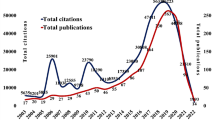Abstract
Citation network analysis is an effective tool to analyze the structure of scientific research. Clustering is often used to visualize scientific domain and to detect emerging research front there. While we often set arbitrarily clustering threshold, there is few guide to set appropriate threshold. This study analyzed basic process how clustering of citation network proceeds by tracking size and modularity change during clustering. We found that there are three stages in clustering of citation networks and it is universal across our case studies. In the first stage, core clusters in the domain are formed. In the second stage, peripheral clusters are formed, while core clusters continue to grow. In the third stage, core clusters grow again. We found the minimum corpus size around one hundred assuring the clustering. When the corpus size is less than one hundred, clustered network structure tends to be more random. In addition even for the corpus whose size is larger than it, the clustering quality for some clusters formed in the later stage is low. These results give a fundamental guidance to the user of citation network analysis.





Similar content being viewed by others
References
Börner, K., Chen, C., & Boyack, K. W. (2003). Visualizing knowledge domains. Annual Review of Information Science & Technology, 37, 179–255.
Boyack, K. W., & Börner, K. (2003). Indicator-assisted evaluation and funding of research: Visualizing the influence of grants on the number and citation counts of research papers. Journal of the American Society for Information Science and Technology, 54, 447–461.
Boyack, K. W., Klavans, R., & Börner, K. (2005). Mapping the backbone of science. Scientometrics, 64, 351–374.
Boyack, K. W., Wylie, B. N., & Davidson, G. S. (2002). Domain visualization using VxInsight for science and technology management. Journal of the American Society for Information Science and Technology, 53, 764–774.
Chen, C. M. (2004) Searching for intellectual turning points: Progressive knowledge domain visualization. Proceedings of the national academy of sciences of the United States of America, Vol. 101, (pp. 5303–5310).
Chen, C. (2006). CiteSpace II: Detecting and visualizing emerging trends and transient patterns in scientific literature. Journal of the American Society for Information Science and Technology, 57, 359–377.
Chen, C., Cribbin, T., Macredie, R., & Morar, S. (2002). Visualizing and tracking the growth of competing paradigms: Two case studies. Journal of the American Society for Information Science and Technology, 53, 678–689.
Hopcroft, J., Khan, O., Kulis, B., & Selman, B. (2004). Tracking evolving communities in large linked networks. Proceedings of the national academy of sciences of the United States of America, Vol. 101, (pp. 5249–5253).
Kajikawa, Y., Ohno, J., Takeda, Y., Matsushima, K., & Komiyama, H. (2007). Creating an academic landscape of sustainability science: An analysis of the citation network. Sustainability Science, 2, 221–231.
Kajikawa, Y., Yoshikawa, J., Takeda, Y., & Matsushima, K. (2008). Tracking emerging technologies in energy research: toward a roadmap for sustainable energy. Technological Forecasting and Social Change (in press).
Klavans, R., & Boyack, K. W. (2006). Identifying a better measure of relatedness for mapping science. Journal of the American Society for Information Science and Technology, 57, 251–263.
Kostoff, R. N., del Río, J. A., Humenik, J. A., García, E. O., & Ramírez, A. M. (2001). Citation mining: Integrating text mining and bibliometrics for research user profiling. Journal of the American Society for Information Science and Technology, 52, 1148–1156.
Morris, S. A., Yen, G., Wu, Z., & Asnake, B. (2003). Time line visualization of research fronts. Journal of the American Society for Information Science and Technology, 54, 413–422.
Newman, M. E. J. (2004). Fast algorithm for detecting community structure in networks. Physical Review E, 69, 066133.
Newman, M. E. J., & Girvan, M. (2004). Finding and evaluating community structure in networks. Physical Review E, 69, 026113.
Price, D. J. D. (1965). Networks of scientific papers. Science, 149, 510–515.
Shibata, N., Kajikawa, Y., & Matsushima, K. (2007). Topological analysis of citation networks to discover the future core papers. Journal of the American Society for Information Science and Technology, 58, 872–882.
Small, H. (1999). Visualizing science by citation mapping. Journal of the American Society for Information Science, 50, 799–813.
Small, H. (2006). Tracking and predicting growth areas in science. Scientometrics, 68, 595–610.
Small, H., & Sweeney, E. (1985). Clustering the science citation index using co-citations I. A comparison of methods. Scientometrics, 7, 391–409.
Takeda, Y., Kajikawa, Y., & Matsushima, K. (2007). Citation network of CVD research: Research topics and journals. Chemical Vapor Deposition, 10, 523–525.
van Raan, A. F. J. (1996). Advanced bibliometric methods as quantitative core of peer review based evaluation and foresight exercises. Scientometrics, 36, 397–420.
White, H. D. (2003). Pathfinder networks and author cocitation analysis: A remapping of paradigmatic information scientists. Journal of the American Society for Information Science and Technology, 54, 423–434.
Acknowledgments
This research was partially supported by New Energy and Industrial Technology Development Organization (NEDO), Grant for Industrial Technology Research (09D47001a). This research was also supported by the Ministry of Education, Science, Sports and Culture (MEXT), Grant-in-Aid for Young Scientists (B) (21700266).
Author information
Authors and Affiliations
Corresponding author
Rights and permissions
About this article
Cite this article
Takeda, Y., Kajikawa, Y. Tracking modularity in citation networks. Scientometrics 83, 783–792 (2010). https://doi.org/10.1007/s11192-010-0158-z
Received:
Published:
Issue Date:
DOI: https://doi.org/10.1007/s11192-010-0158-z




